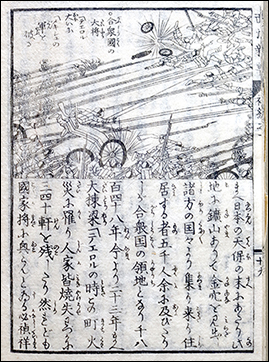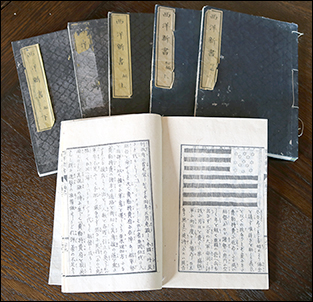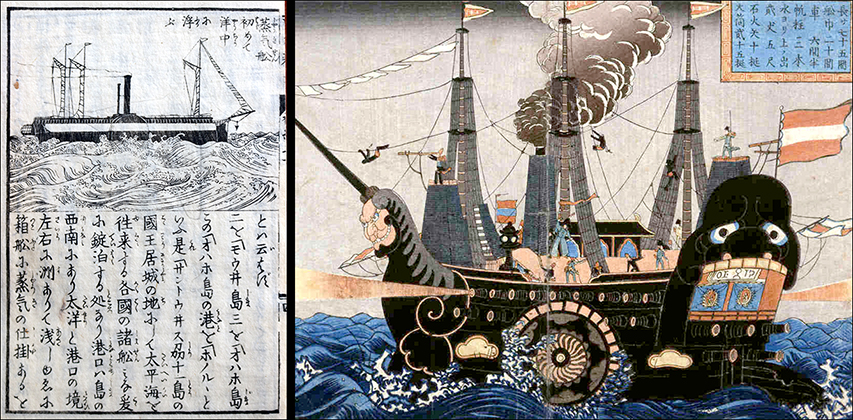North, South, Far East: The Civil War through Japanese Eyes
Arriving in Nagano, Japan, in the summer of 1955 as part of a seven-nation goodwill tour sponsored by the U.S. State Department, acclaimed Southern novelist William Faulkner was astonished by the reception he received. Though he had been writing for thirty years, Faulkner’s work attracted little attention at home and even less abroad until 1949, when he was awarded the Nobel Prize for Literature. Whether the newly minted laureate ever fully understood why the Japanese, who numbered among his biggest international fans, took an interest in his work is an open question, but similarities between Faulkner’s South and post-war Japan are not hard to find. Both had lost to the “Yankees,” both suffered humiliating occupation at the hands of an invading army, both were intensely proud societies determined to rebuild on their own terms, for better or worse. “Japan’s loss in World War II has haunted the Japanese,” writes literary scholar Takako Tanaka, “just as the defeat of the Civil War haunted white Southerners.”
Few realize that Japanese readers were already making connections between the Civil War and their own history long before they ever heard Faulkner’s name, as we learn from a book recently acquired by the LSU Libraries’ Special Collections—Seiyo shinsho (“New Book on the West”).
 Seiyo shinsho" data-title="An American battle scene, from Seiyo shinsho" data-align="center"/>
Seiyo shinsho" data-title="An American battle scene, from Seiyo shinsho" data-align="center"/>
Published in Tokyo in 1872, this multi-volume history of the United States contains approximately 80 woodcut illustrations and six color maps that offer fascinating and often comically inaccurate insight into how the Japanese saw Americans in the nineteenth century. At the time of the book’s publication, it had been fewer than twenty years since Commodore Matthew Calbraith Perry sailed a fleet of warships into Edo (now Tokyo) Bay and used “gunboat diplomacy” to bully Japan into ending its strict isolationist policy. (In his 1851 novel Moby Dick, published the year before Perry’s departure, Herman Melville had referred to the famously self-secluded country as “that double-bolted land.”) Once the latch was lifted, however, the Japanese were eager to learn about their new trading partners through books such as Seiyo shinsho, if only as part of a determined strategy to avoid the fate of China and other Asian countries that had fallen prey to European colonial powers.
One subject covered in the book—western military history—would have been of special interest in 1872. The American Civil War, in particular, or nanboku senso (“The North-South War”) as it is called in Japanese, was a fine example of how a western country had undergone a major social upheaval not entirely different from what had just happened in Japan. Whether the issue was slavery and states’ rights or how to deal with western intruders and the consequences of modernization, the 1850s and ‘60s saw opinions grow ever more divided and heated. In Japan, the country’s de facto ruler, the shogun, considered modernization the best defense against the west. Rural lords (daimyo) and Japan’s warrior class, the samurai, disagreed. Unhappy with the way shogunate officials were handling foreign policy and fearing collapse of the ancient social hierarchy, daimyo and samurai united behind the emperor, who up until then had had little political power. Tensions culminated in the Boshin War of 1868-69. Having defeated the shogun, the emperor then changed course, turning against the traditionalists and launching the country headlong into rapid modernization. The Meiji Restoration, as this period came to be known, saw not only technological and military advancements, but also the end of feudalism and special privileges for the elite.
 What similarities existed between Japan’s own internal struggle and that of the Americans? Just as many in the United States argued that the nation could not continue “half slave, half free,” so too did Japanese policymakers recognize the impracticality and ultimate impossibility of preserving a medieval society in an increasingly industrial world. Likewise, the triumph of the U.S. federal government in 1865 foreshadowed the consolidation of power under the Japanese emperor not long afterward. Southerners’ dread of abolitionists and free blacks, and especially their attempts to limit these groups’ freedom of speech by threats, deportation, and even murder, mirrors Japanese isolationists’ anxieties about and tactics for dealing with “foreign barbarians.” The mythos of national reform led by a single, enlightened figure—whether Abraham Lincoln or the Meiji Emperor—is yet another common thread. So, too, is betrayal, exemplified in Japan by the emperor’s desertion of the traditionalists and in the United States nearly a decade later by the federal government’s decision to stop enforcing civil rights for African Americans at the end of Reconstruction.
What similarities existed between Japan’s own internal struggle and that of the Americans? Just as many in the United States argued that the nation could not continue “half slave, half free,” so too did Japanese policymakers recognize the impracticality and ultimate impossibility of preserving a medieval society in an increasingly industrial world. Likewise, the triumph of the U.S. federal government in 1865 foreshadowed the consolidation of power under the Japanese emperor not long afterward. Southerners’ dread of abolitionists and free blacks, and especially their attempts to limit these groups’ freedom of speech by threats, deportation, and even murder, mirrors Japanese isolationists’ anxieties about and tactics for dealing with “foreign barbarians.” The mythos of national reform led by a single, enlightened figure—whether Abraham Lincoln or the Meiji Emperor—is yet another common thread. So, too, is betrayal, exemplified in Japan by the emperor’s desertion of the traditionalists and in the United States nearly a decade later by the federal government’s decision to stop enforcing civil rights for African Americans at the end of Reconstruction.
Other connections between Japan and the Civil War would not have been apparent to readers of Seiyo shinsho, but are no less interesting. There are even connections to Louisiana. The case of a Confederate warship is one of the more surprising. In 1869, zealous to build up a modern navy, the Japanese acquired the CSS Stonewall from the U.S. government. The 95-ton ironclad ram had been built in Bordeaux, France, five years earlier at the prompting of former Louisiana senator John Slidell, of Trent Affair fame, who was on a diplomatic mission to secure French recognition of the Confederacy. By an incredible coincidence, Slidell was Commodore Perry’s brother-in-law. The Civil War ended before the Stonewall could be delivered to a Southern port. Renamed the Kotetsu (“Ironclad”) by its new Japanese owners, the ship’s first mission was to the northern island of Hokkaido to fight the last of the shogun’s supporters in the Boshin War.
The USS Mississippi is another unexpected connection. Built under Perry’s personal supervision, this sleek paddlewheel frigate boasted the latest technology and served as the Commodore’s flagship on and off during his expedition to establish American relations with Japan. Like most of Perry’s fleet, it went on to see action in the Civil War. In November 1861, the Mississippi joined the Gulf blockading squadron off the coast of Louisiana and later participated in Admiral Farragut’s assault on the forts guarding New Orleans. The ship that had once survived a powerful typhoon off the coast of Japan said “sayonara” on May 14, 1863, at the siege of Port Hudson. Stuck on a sand bar, her crew set her on fire to keep her from falling into Confederate hands. She eventually slid off the bar and drifted downriver for several hours before the flames reached her powder magazine. The wreck has never been salvaged. Hardly anybody today realizes that one of the famous kurofune (“black ships”) that sailed into Edo Bay as part of one of history’s most influential diplomatic missions now lies at the bottom of her namesake, the Mississippi River, less than twenty miles north of Baton Rouge.
 Mississippi, as seen by Japanese artists (Source: Seiyo shinsho and Wikimedia Commons)" data-title="Ships from Perry's fleet, possibly the USS Mississippi, as seen by Japanese artists (Source: Seiyo shinsho and Wikimedia Commons)" data-align="center"/>
Mississippi, as seen by Japanese artists (Source: Seiyo shinsho and Wikimedia Commons)" data-title="Ships from Perry's fleet, possibly the USS Mississippi, as seen by Japanese artists (Source: Seiyo shinsho and Wikimedia Commons)" data-align="center"/>
--
Sources and Further Reading:
Joel Williamson, William Faulkner and Southern History (Oxford, 1993), 296-8; Takako Tanaka, “The Global/Local Nexus of Patriarchy: Japanese Writers Encounter Faulkner,” in Annette Trefzer and Ann J. Abadie, eds., Global Faulkner (Oxford, MS, 2009).
Hansgeorg Jentschura, Warships of the Imperial Japanese Navy, 1869–1945 (Annapolis, 1977).
Arthur Walworth, Black Ships off Japan: The Story of Commodore Perry’s Expedition (New York, 1946).
Peter Booth Wiley, Yankees in the Land of the Gods: Commodore Perry and the Opening of Japan (New York, 1990)
NUMA (National Marine and Underwater Agency) website, http://www.numa.net/expeditions/mississippi-u-s-s/ (accessed July 19, 2015).
(This story was originally published in the Civil War Book Review, Summer 2015.)
